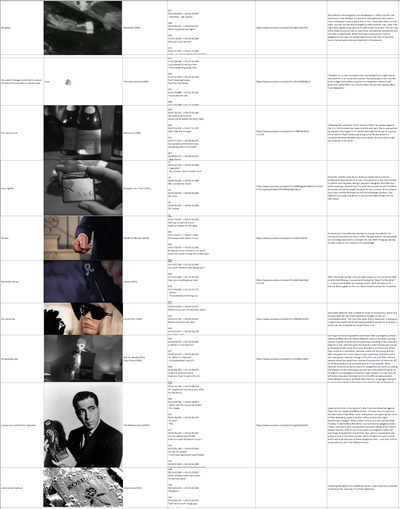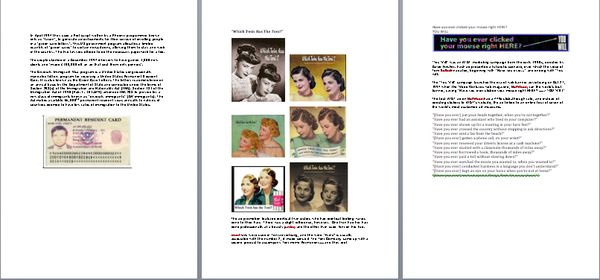User:Emily/proposal 0.02
Introduction
- A: You have something that moves you along without people knowing it. It is something crucial to you, right? If it was absent, would ruin your life. What is that called again?
- B: That’s a MacGuffin.
A MacGuffin is said as a plot device in fiction films in the form of some goal, desired object, or other motivator that the protagonist pursues and moves the plot forward. Following my interest in MacGuffin, precisely the MacGuffin effect. According to Zizek, "the MacGuffin is the purest case of what Lacan calls objet petit a: a pure void which functions as the object - cause of desire. That would be then the precise definition of the real object: a cause which in itself does not exist - which is present only in a series of effects, but always in a distorted, displaced way. If the Real is the impossible, it is precisely this impossibility which is to be grasped through its effects." The effect of MacGuffin in fiction films maybe easier to grasp, on the contrary it may be harder to perceive in the representation of our daily commodities, concerns, like in advertising. By examining its function through different examples from certain films and advertising cases, my work here will reveal the less visible mechanism of control through MacGuffin Objects. Through mere differences of the MacGuffins play between fiction and reality, the work also imply "the protagonist is an emblem of the human subject in an abstract representation." MacGuffins are “material metaphors” they have a “reality effect”. They build the symbolic order and they make real things happen.
Possible Outcome
The work involves a collection of possibly 12 Macguffin objects. They are based on the merging of real objects and fictional objects, which are taken from films, and adverting campigns. The representation of these objects contains physical form as well as visual, audio materials. They are extracted and altered from their "official" images and scripts (films and advertisement). They act like placeholders in my work, which means they can be replaced by any other objects. They are emblems/ symbolic.
- There is a main narration shown as a dialogue integrating each object within the collection spoken by two narrators played by the same person. The dialogue start with one asking the other “you have something that moves you along without people knowing it. It is something crucial to you, right? If it was absent, would ruin your life. What is that called again? ... “ (The moving images, the dialogue scene sometimes looks like freezers like The Cast in Omer Fast’s film (in may case it would like sometimes only eyes movement or a hand gesture in order to make audiences focus on the voice narration.)
- Reenactment – the dialogue scene. The objects are not physically shown in the video but be talked by the protagonist. (Sometimes they talk about one object with their hand holding it but the audiences only see the holding gesture with out the physical thing.)
- Remake the objects in a uniform way (hybrid objects at the margin of reality and fiction) (using same material? / in the same color? /)
- In some cases there is no physical form for the MacGuffins. In fiction: for instance, the coded message in a tune in the film, The Lady Vanishes (1938), an assassination plan in spy films, or some goals, puzzles that protagonists try to pursue or solve. In reality: the fear arose by the campaign of a general election 'Labour Still Isn't Working'; The famous MacGuffin mentioned by Zizek, the Weapon of Mass Destruction. Then the physical form I want to create here for the MacGuffin objects are metaphors in themselves. It is also dealing with different ways of representing but they all merely function as placeholders desiring their effects.
Practicle steps
- Complete the collection
- Make the scripts for the narrators
- Think/Make the dialogue scene (in what kind of settings/environment? Interview/casual talk; what kind of protagonist)
- Record the voice narration
Context & research trends
A MacGuffin is said as a plot device in the form of some goal, desired object, or other motivator that the protagonist pursues and moves the plot forward. The name "MacGuffin" appears to originate in 20th-century filmmaking, and was popularized by Alfred Hitchcock in the 1930s. He often quoted the following story to illustrate its nothingness: "Two gentlemen meet on a train, and the one is struck by the extraordinary package being carried by the other. He asks his companion, 'What is in that unusual package you are carrying there?' The other man replies, 'That is a MacGuffin.' 'What is a MacGuffin?' asks the first. The second says, 'A MacGuffin is a device used for killing leopards in the Scottish highlands.' Naturally the first man says, 'But there are no l!eopards in the Scottish highlands.' 'Well,' says the second, 'then that's not a MacGuffin, is it?’”
Zizek find this pretext, Macguffin in the real world. The “Iraqi weapons of mass destruction” fit perfectly the status of MacGuffin, especially comparing with the “radioactive diamonds” in one of Hitchcock’s film, Notorious. But what really left behind was a ultimate paradox. According to Zizek, “the very strategy of preemptive strikes will contribute to the proliferation of nuclear weapons. When US attacked Iraq and not North Korea, the underlying logic was clear: once a "rogue" state crosses the critical limit and already acquires substantial nuclear weapons, one cannot simply attack it because one risks a nuclear backlash killing millions on our side. This, precisely, was the lesson North Korea drew from the attack on Iraq: the regime sees nuclear weapons as the only guarantee of its survival.” It’s exact what I talked about the double which is asked to exist and the h!idden function that the real MacGuffin played.
- The MacGuffin effects
- Objet petit a is any object which sets desire in motion
- Lacan's objet petit a (object small a) refers to a certain excess that is in the object more than the object the object-cause of desire. We might say that it is not so much the object of desire as the desirous element that can reside in any object: the drive towards some elusive point of consummation that may be quite incidental to the object itself (e.g. a shirt that was once worn by Elvis). It is that which "authenticates" the object and/or the experience of having it (e.g. the idea of virginity in Buñuel's That Obscure Object of Desire). If we take Tarrantino's Pulp Fiction then we see that the narrative ultimately revolves around a lost/stolen object inside a case that must be retrieved by Vincent and Jules. This object cannot be seen and is only alluded to in the reflective glow of the protagonists' faces, This is the objet petit a: something whose authenticity cannot be represented or substantialized and which is but a reflection of the drive to complete the (broken) circuit of enjoyment and to be reconciled with (impossible) desire itself.
- The Sublime Object of Ideology -- Slavoj Žižek
- Hitchcock interview Martin Scorsese about MacGuffin
- examples in reality(W.M.D) and in films(North by Northwest)
- but-there-are-no-lions-in-the-scottish-highlands-john-wei.pdf
Relation to Previous Works
In the last academic year, I have been working on manipulation of audiovisual content (mainly cinematic materials), examining how could it alter the way of seeing. My work started in a quite simple manner, in which films are utilised as input to produce books (link), videos(link), browser- based works(link), and interactive installations(link). Through these works, different accessibilities are provided and meanwhile doubts are bought forward on the ability of recognition - namely the ability to recognise time and space, fiction and fact. ! Starting from my interest in video editing, the practice and research brought me back to think about montage, but in a much broader and freer manner. I started to research the “cut-up” techniques through different times, from literature to cinema works and data manipulations. All these works are more or less leave a space for the “performativity” inherited from their original materials. ! Departing from the exploration of performativity, I considered about the control on the works like for example from Gysin which I thought at first were freedom. Interestingly, the control mechanism is to hardwire conceptual frame with technologies which later on may translate to be (standard) code. The materials to feed perception become layered and less visible. It brings the question on what this control would affect on cognition, from both human level and machine level (or the architecture of technology).
References
Hitchcock's 1962 interview with Francois Truffaut
- "The main thing I’ve learned over the years is that the MacGuffin is nothing. I’m convinced of this, but I find it very difficult to prove it to others. My best MacGuffin, and by that I mean the emptiest, the most nonexistent, and the most absurd, is the one we used in North by Northwest. The picture is about espionage, and the only question that’s raised in the story is to find out what the spies are after. Well, during the scene at the Chicago airport, the Central Intelligence man explains the whole situation to Cary Grant, and Grant, referring to the James Mason character, asks, “What does he do?” The counterintelligence man replies, “Let’s just say that he’s an importer and exporter.” “But what does he sell?” “Oh, just government secrets!” is the answer. Here, you see, the MacGuffin has been boiled down to its purest expression: nothing at all!"
Hitchcock's June 8, 1972 appearance on the Dick Cavett Show http://www.openculture.com/2013/06/alfred_hitchcock_with_dick_cavett.html
- "It is the thing that spies are always after"+"the thing that the characters on the screen worry about but the audiences don't care" ?? +"a scene in a English train - what's the pakage above your head there"
- MacGuffin is that it contains the word "guff", which means a load of nonsense.
- "but watch out for the MacGuffin. It will lead you nowhere"-- Donald Spoto.
Johan Grimonprez on Hitchcock and Television http://desistfilm.com/q-a-johan-grimomprez/
- 9/11 as live version of The Birds(1963)-- For Žižek, 9/11 represents the ultimate Hitchcockian threat, which suddenly shows up from nowhere. He refers to the sequence where Melanie (Tippi Hedren) comes closer to the Bodega Bay in a small boat and a seagull, at first perceived as an imperceptible black spot, suddenly dives on her and hurts her to the forehead ; an image which stunningly looks like the one of the plane crashing into the second tower of the World Trade Center.
- Dial H_I_S_T_O_R_Y(1997)-- Our way to access the world through its double, its representation, have changed out connection to reality.
- Looking for Alfred (2005)
- Double Take(2007-2009)
- For Hitchcock, what feeds into the wheel of suspense is the MacGuffin that sets the plot in motion. It's an element gives impetus to the process of narration, or that attracts the viewer's attention, but is not important by itself.
- "We always have to do things twice"+"the misunderstanding becomes the culture, the poetry of misunderstandings begins. And the words and the things start to separate"+"Being constantly faced with the other side of things increases the feeling of irony."
- Hitchcock & Magritte -- bowler hat + pipe
The Purloined Letter (the letter is hidden in the open)
- detective story(the third one), the origin of the genre. It directly influenced on Sherlock Holmes
- Jacques Lacan's "Seminar on 'The Purloined Letter'" (1956)
- Lacan vs. Derrida on Poe's "The Purloined Letter"
- works takes position where we define reality by placing it precisely between fact and fiction. But it's reality itself that plays with its own representation, and this is what Elsaesser calls "the ontological changeing"


